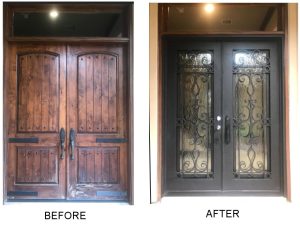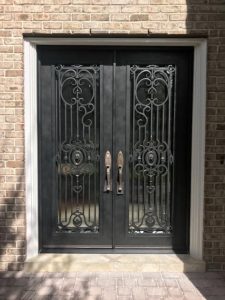History Of Wrought Iron Doors
Have you ever explored the fascinating history of wrought iron doors? For hundreds of years, it was used to create anything from weapons to gates. The elegant designs molded into the metal were intricate markers of nobility. Their resilience protected many lives from invaders and aggressors of all kinds. While it’s very popular, many people don’t know what wrought iron actually is. Our blog post today will elaborate on this and depict the historic legacy it has established.
Origin Of Wrought Iron
The term “wrought” essentially means “to work”, so for this metal, in particular, that meant hammering it or rolling it while the metal was hot and molten. The first display of this metalworking was seen in the second century BCE in the area where modern-day Turkey is located. However, ironwork dates as far back as 3500 BCE in Egyptian and Mesopotamian cultures. At the time, it’s prevalence was just as widespread. You could see this iron being used in a variety of different styles. Whether it was tools, weapons, or gates, it was the favorite among artificers.
As the knowledge of this trade spread across the world, it began replacing all kinds of different metals that were previously the best options around. By the 8th century, people were using the iron to arm their soldiers and by the 5th century, iron had replaced bronze as the metal of choice throughout the entirety of Europe.

The transition to wrought iron can make a huge difference.
While advancements in technology were slim before the middle ages, the medieval period would welcome new techniques with open arms. Wrought iron became more and more common for all sorts of different applications as their skillsets increased the usability of this metal. All throughout the European and middle eastern world, wrought iron was being used for grand doors and windows of buildings. Their strength and durability allowed them to be perfect for protection but the moldability it possessed made it ideal for decorative purposes as well.
This was the trend that continued throughout the first millennia of the Common Era (CE). The innovations to this trade would not surface until the 16th and 17th centuries when the sophistication of this metal was so elaborate that it was used for cathedrals, and courtyards. By the 1800s, new techniques allowed for a huge expansion that gave way to iron being used in many new and different applications. This could be seen in the development of railroads and warships.
After the industrial revolution, wrought iron once again exploded into the mainstream. Its uses were so common that it was could be seen all throughout the field and property, in all sorts of household items. That would consist of utensils, grates, and stovetops. They made locks, lamps, grand fireplaces, even doors! The possibilities were seemingly endless.
How Is Wrought Iron Made?
In order to yield the type of iron that could be workable, it had to be smelted. At the same time, you must reduce the carbon content to ensure strength and resilience. The most common metal before this was cast iron, however, it has a much higher carbon content. After lowering the carbon levels, blacksmiths found that wrought iron was more malleable and far less brittle than it’s predecessors. Later in its evolution, it was discovered that wrought iron was purer than any of the past metals that came before it.
There are two different processes that are used to make wrought iron. The first method was used up until the late 1700s when a new practice was perfected. However, the method is known for using charcoal was still very effective for its time. The procedure consisted of using charcoal as a heat source and reducing agent for smelting.

Would you like custom wrought iron doors?
The result was a separation of iron from the ore. In 1784 however, the benefits of water power and blast furnaces made even more strides. This was when the first use of the “puddling technique” was used. By melting the iron down and stirring it, you were able to rid the metal of more impurities which made it far more useful in many different applications. Before the development of refined steel in the 19th century, this was by far the most popular metal work around.
Now, We Use Wrought Iron For Beautiful Doors!
There is a long line of discovery and challenges that we had to triumph over before wrought iron could become so common. Today, these eclectic iron doors can be seen in many nice houses and buildings throughout the world. However, this artisan work prevailed through centuries of hard labor, championing the title of luxury and power through fire and brimstone. Feel free to browse through our doors and see how this metal has been worked into our designs!
